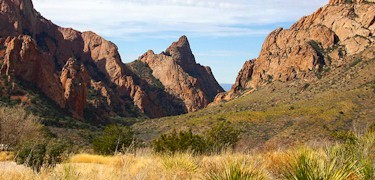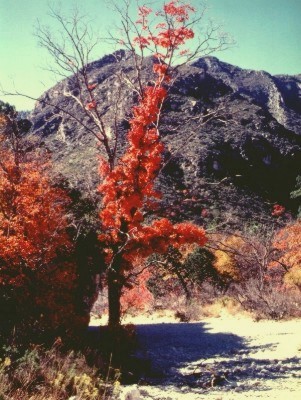
Big Bend National Park - photo by US National Park Service
 Big Bend National
Park http://www.nps.gov/bibe/index.htm
Big Bend is one of the largest and least visited of America’s national parks. Over 801,000 acres await your exploration and enjoyment. From an elevation of less than 2,000 feet along the Rio Grande to nearly 8,000 feet in the Chisos Mountains, Big Bend includes massive canyons, vast desert expanses, and the entire Chisos Mountain range. Big Bend National Park also marks the northernmost range of many plants and animals, such as the Mexican long-nosed bat. Ranges of typically eastern and typically western species of plants and animals come together or overlap here. Here many species are at the extreme limits of their ranges. Latin American species, many from the tropics, range this far north, while northern-nesting species often travel this far south in winter. Contrasting elevations create additional, varied micro-climates that further enhance the diversity of plant and animal life and the park’s wealth of natural boundaries.
Big Bend National
Park http://www.nps.gov/bibe/index.htm
Big Bend is one of the largest and least visited of America’s national parks. Over 801,000 acres await your exploration and enjoyment. From an elevation of less than 2,000 feet along the Rio Grande to nearly 8,000 feet in the Chisos Mountains, Big Bend includes massive canyons, vast desert expanses, and the entire Chisos Mountain range. Big Bend National Park also marks the northernmost range of many plants and animals, such as the Mexican long-nosed bat. Ranges of typically eastern and typically western species of plants and animals come together or overlap here. Here many species are at the extreme limits of their ranges. Latin American species, many from the tropics, range this far north, while northern-nesting species often travel this far south in winter. Contrasting elevations create additional, varied micro-climates that further enhance the diversity of plant and animal life and the park’s wealth of natural boundaries.
 Big Thicket
National Preserve http://www.nps.gov/bith/
The Preserve consists of nine land units and six
water corridors encompassing more than 97,000 acres. Big Thicket was the
first Preserve in the National Park System established October 11, 1974,
and protects an area of rich biological diversity. A convergence
of ecosystems occurred here during the last Ice Age. It brought
together, in one geographical location, the eastern hardwood forests,
the Gulf coastal plains, and the midwest prairies.
Big Thicket
National Preserve http://www.nps.gov/bith/
The Preserve consists of nine land units and six
water corridors encompassing more than 97,000 acres. Big Thicket was the
first Preserve in the National Park System established October 11, 1974,
and protects an area of rich biological diversity. A convergence
of ecosystems occurred here during the last Ice Age. It brought
together, in one geographical location, the eastern hardwood forests,
the Gulf coastal plains, and the midwest prairies.

Autumn in McKittrick Canyon, Guadalupe Mountains National Park -
photo by Edward Frank
 Guadalupe Mountains National Park http://www.nps.gov/gumo/
Rising from the desert, this mountain mass contains portions of the world's most extensive and significant Permian limestone fossil reef. Also featured are a tremendous earth fault, lofty peaks, unusual flora and fauna, and a colorful record of the past. Guadalupe Peak, highest point in Texas at 8,749 feet; El Capitan, a massive limestone formation; McKittrick Canyon, with its unique flora and fauna; and the "Bowl", located in a high country conifer forest, are significant park features. Deep within McKittrick Canyon a spring-fed stream flows year round and even through the most severe droughts. The sheltering walls of McKittrick Canyon and the presence of water allow the remnants of Ice Age woodland to survive in a region noted for its heat and aridity. The higher elevations receive twice the amount of rainfall than the surrounding desert, and also preserve a remnant of species widespread during the Last Ice Age.
Guadalupe Mountains National Park http://www.nps.gov/gumo/
Rising from the desert, this mountain mass contains portions of the world's most extensive and significant Permian limestone fossil reef. Also featured are a tremendous earth fault, lofty peaks, unusual flora and fauna, and a colorful record of the past. Guadalupe Peak, highest point in Texas at 8,749 feet; El Capitan, a massive limestone formation; McKittrick Canyon, with its unique flora and fauna; and the "Bowl", located in a high country conifer forest, are significant park features. Deep within McKittrick Canyon a spring-fed stream flows year round and even through the most severe droughts. The sheltering walls of McKittrick Canyon and the presence of water allow the remnants of Ice Age woodland to survive in a region noted for its heat and aridity. The higher elevations receive twice the amount of rainfall than the surrounding desert, and also preserve a remnant of species widespread during the Last Ice Age.
 Ancient Cross Timbers Project: http://www.uark.edu/misc/xtimber/
The Cross Timbers are the post oak and blackjack oak woodlands that form
the western frontier of deciduous forests in Texas, Oklahoma, and
southeastern Kansas. Literally thousands of acres of ancient forest
survive in the Cross Timbers because these stout oaks were too short and
craggy for commercial sawlog production. Post oak trees up
to 400 years old and red cedar trees over 500 years old have been found
in these interesting woodlands. Unfortunately, the great antiquity of
the uncut Cross Timbers is not widely appreciated and they continue to
be destroyed. This project is dedicated to the location and
appreciation of these authentic ancient forest remnants.
Ancient Cross Timbers Project: http://www.uark.edu/misc/xtimber/
The Cross Timbers are the post oak and blackjack oak woodlands that form
the western frontier of deciduous forests in Texas, Oklahoma, and
southeastern Kansas. Literally thousands of acres of ancient forest
survive in the Cross Timbers because these stout oaks were too short and
craggy for commercial sawlog production. Post oak trees up
to 400 years old and red cedar trees over 500 years old have been found
in these interesting woodlands. Unfortunately, the great antiquity of
the uncut Cross Timbers is not widely appreciated and they continue to
be destroyed. This project is dedicated to the location and
appreciation of these authentic ancient forest remnants.
 Boykin Spring
Longleaf, in Angelina National Forest, eastern Texas (Angelina
County): approximately 90 acres of old-growth longleaf within a 384-acre
area. The herbaceous layer includes more than 170 species.
The area is to the east of the 14,000-acre Upland Island wilderness, one
of the five remaining ancient Texas wilderness areas. http://www.carnivorousplantsoftexas.org/s16angelina.html
Boykin Spring
Longleaf, in Angelina National Forest, eastern Texas (Angelina
County): approximately 90 acres of old-growth longleaf within a 384-acre
area. The herbaceous layer includes more than 170 species.
The area is to the east of the 14,000-acre Upland Island wilderness, one
of the five remaining ancient Texas wilderness areas. http://www.carnivorousplantsoftexas.org/s16angelina.html
 Texas State Park
Guide http://www.tpwd.state.tx.us/parkguide/
This electronic version of the Texas State Park Guide is meant to help you plan the best trip possible, with maps and information on some 120 parks and historic sites.
Texas State Park
Guide http://www.tpwd.state.tx.us/parkguide/
This electronic version of the Texas State Park Guide is meant to help you plan the best trip possible, with maps and information on some 120 parks and historic sites.
 Monahans
Sandhills State Park http://www.tpwd.state.tx.us/park/monahans/
Monahans Sandhills State Park consists of 3840 acres of sand dunes, some up to 70 feet high, in Ward and Winkler Counties, about a half-hour's drive west of Odessa. The park is only a small portion of a dune field that extends about 200 miles from south of Monahans westward and north into New Mexico. Most of these dunes are stabilized by vegetation, but the park is one area where many dunes are still active. Active dunes grow and change shape in response to seasonal, prevailing winds. Shinoak
(Quercus havardii), one of the plants which stabilize the dunes, is not a stunted or dwarfed form of a larger tree but a fully mature plant which bears an abundance of large acorns and usually stands less than four feet tall.
Monahans
Sandhills State Park http://www.tpwd.state.tx.us/park/monahans/
Monahans Sandhills State Park consists of 3840 acres of sand dunes, some up to 70 feet high, in Ward and Winkler Counties, about a half-hour's drive west of Odessa. The park is only a small portion of a dune field that extends about 200 miles from south of Monahans westward and north into New Mexico. Most of these dunes are stabilized by vegetation, but the park is one area where many dunes are still active. Active dunes grow and change shape in response to seasonal, prevailing winds. Shinoak
(Quercus havardii), one of the plants which stabilize the dunes, is not a stunted or dwarfed form of a larger tree but a fully mature plant which bears an abundance of large acorns and usually stands less than four feet tall.
 An Old-Growth Definition for Southwestern Subtropical Upland Forests,
Diamond, David D., 1998. Gen. Tech. Rep. SRS-21. Asheville, NC: U.S. Department of Agriculture, Forest Service, Southern Research Station. 7 p. GTR-SRS-021. Mainly evergreen, broad-leaved forests in the Southwestern United States are restricted to the Lower Rio Grande Valley of Texas. The soils and long growing season make this region valuable cropland, and, thus, almost all of the area once occupied by this forest type has been converted to row crops. Remaining old-growth forests are usually dominated by some combination of the broad-leaved evergreen Texas ebony and a host of other species. Few quantitative studies have described the composition of this forest type, and, likewise, little is known of the dynamics. Droughts, flooding regime, and fire were large-scale disturbance factors. Now, the Rio Grande is used extensively for irrigation, and flooding is controlled. Therefore, the presettlement water regime has been greatly altered, and vegetation of the remaining forest fragments is also adjusting to the new moisture regime. Some areas are wetter and some drier than in historical times. Many of the fragments that remain have already been incorporated into public ownership by the U.S. Fish and Wildlife Service or the Texas Parks and Wildlife Department.
http://www.srs.fs.usda.gov/pubs/gtr/gtr_srs021.pdf
642 kb.
An Old-Growth Definition for Southwestern Subtropical Upland Forests,
Diamond, David D., 1998. Gen. Tech. Rep. SRS-21. Asheville, NC: U.S. Department of Agriculture, Forest Service, Southern Research Station. 7 p. GTR-SRS-021. Mainly evergreen, broad-leaved forests in the Southwestern United States are restricted to the Lower Rio Grande Valley of Texas. The soils and long growing season make this region valuable cropland, and, thus, almost all of the area once occupied by this forest type has been converted to row crops. Remaining old-growth forests are usually dominated by some combination of the broad-leaved evergreen Texas ebony and a host of other species. Few quantitative studies have described the composition of this forest type, and, likewise, little is known of the dynamics. Droughts, flooding regime, and fire were large-scale disturbance factors. Now, the Rio Grande is used extensively for irrigation, and flooding is controlled. Therefore, the presettlement water regime has been greatly altered, and vegetation of the remaining forest fragments is also adjusting to the new moisture regime. Some areas are wetter and some drier than in historical times. Many of the fragments that remain have already been incorporated into public ownership by the U.S. Fish and Wildlife Service or the Texas Parks and Wildlife Department.
http://www.srs.fs.usda.gov/pubs/gtr/gtr_srs021.pdf
642 kb.
 GORP
- Texas Wilderness Areas http://gorp.away.com/gorp/resource/us_wilderness_area/tx.htm
Big Slough Wilderness Area, Indian Mounds Wilderness Area, Little Lake Creek Wilderness Area, Turkey Hill Wilderness Area, Upland Island Wilderness Area.
GORP
- Texas Wilderness Areas http://gorp.away.com/gorp/resource/us_wilderness_area/tx.htm
Big Slough Wilderness Area, Indian Mounds Wilderness Area, Little Lake Creek Wilderness Area, Turkey Hill Wilderness Area, Upland Island Wilderness Area.